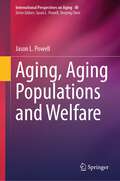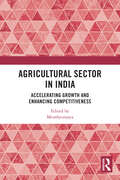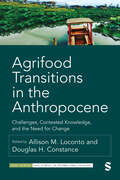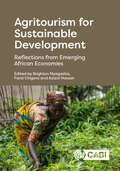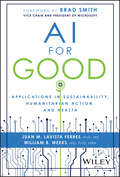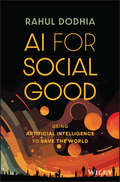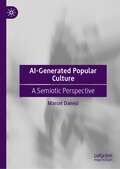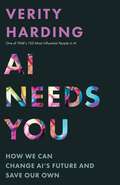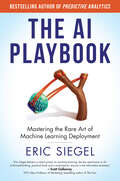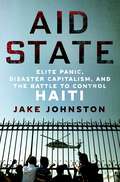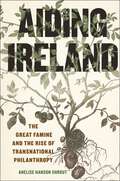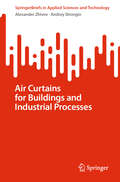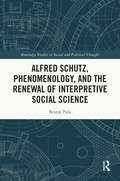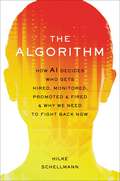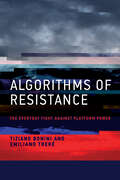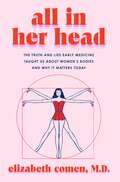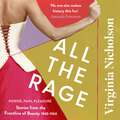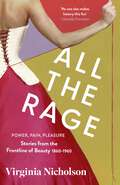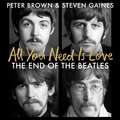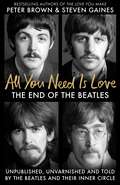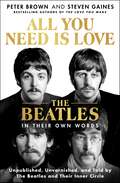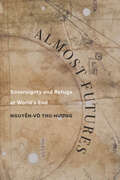- Table View
- List View
Aging, Aging Populations and Welfare (International Perspectives on Aging #40)
by Jason L. PowellAs the world experiences a rapid increase in the aging population, it is essential to address the challenges and opportunities that arise as a result. This book explores the significant impact of aging on individual well-being, societal welfare systems, and the global economy. By examining the multifaceted aspects of aging, demography and welfare, the book aims to provide a comprehensive and critical narrative to navigating these challenges and achieving better outcomes for both older individuals and society as a whole. The book has a critical approach running through it; despite this, there is a need to do something with the critical questions and focus on sustainable solutions to problems and issues an aging population poses to researchers, policy makers and older people themselves. In essence, the primary purpose of this book is to shed light on the complexities surrounding aging, demography and its intersection with welfare systems. By delving into various perspectives, such as social, economic, and healthcare considerations, this book highlights the holistic understanding needed to address the challenges associated with an aging population effectively.
Agricultural Sector in India: Accelerating Growth and Enhancing Competitiveness
by MruthyunjayaThis book presents a comprehensive overview of a range of concepts, methods, strategies and policies in agriculture and natural resource management, environmental economics, production economics and sustainable agricultural development. It explores effective analytical tools and science, innovations, and management solutions to enhance yields, manage the supply chain, strengthen institutional mechanisms, and service and support systems for farmers. It highlights the importance of enabling policies which can benefit farmers, resulting in cost-efficient and quality-improving farm practices, increased profits and income for farmers, and better management of natural resources. The essays in the book honour the academic, teaching, and research contributions of Professor R. Ramanna in the field of agricultural economics. They also address issues which are relevant to the growing research in sustainable agricultural development and natural resource management including the use of new concepts, tools, analyses, technologies, innovations, and policy strategies modelled in local contexts that can easily be scaled and applied to similar contexts elsewhere. This book will be of interest and use to students, researchers, practitioners,and policymakers working in varied fields of agricultural economics, sustainable development, public policy, rural sociology, political economy, economics of innovation, institutional economics, and industrial organisation.
Agrifood Transitions in the Anthropocene: Challenges, Contested Knowledge, and the Need for Change (SAGE Studies in International Sociology)
by Allison M. Loconto Douglas H. ConstanceThe greatest challenges of the twenty-first century stem from the fact that we are now living in a new epoch: the Anthropocene. The human footprint on the planet can no longer be denied. One of the greatest and most essential human innovations, agriculture, is being increasingly recognised as a leading contributor to climate change. According to global governance bodies, the world will need to feed a predicted nine billion people by 2050. However, in this Anthropocene, we must address the environmental inequalities in how these people will be fed. This book explores our current societal struggles to transition towards more sustainable agrifood systems. It suggests that debates around sustainable agriculture must be social as well as technical, exploring the growth of social movements campaigning for more democratic food systems. However, as each chapter demonstrates, both the problems and the solutions in sustainable agriculture are highly contested. Using the term ′agrifood′ to capture the nexus between research, governance and the environment knowledge-environment-governance, this book provides an in-depth and wide-ranging account of current research around agricultural production and food consumption. The book introduces the Anthropocene along with the fundamental question that it poses about human-nature interactions. It outlines the core concerns related to agriculture and food and the debates around the need for agrifood system transitions. Each chapter investigates controversies in the field through case studies. These contributions offer a call for sociologists of agriculture and food to engage with the controversies unfolding in the Anthropocene.
Agrifood Transitions in the Anthropocene: Challenges, Contested Knowledge, and the Need for Change (SAGE Studies in International Sociology)
by Allison M. Loconto Douglas H. ConstanceThe greatest challenges of the twenty-first century stem from the fact that we are now living in a new epoch: the Anthropocene. The human footprint on the planet can no longer be denied. One of the greatest and most essential human innovations, agriculture, is being increasingly recognised as a leading contributor to climate change. According to global governance bodies, the world will need to feed a predicted nine billion people by 2050. However, in this Anthropocene, we must address the environmental inequalities in how these people will be fed. This book explores our current societal struggles to transition towards more sustainable agrifood systems. It suggests that debates around sustainable agriculture must be social as well as technical, exploring the growth of social movements campaigning for more democratic food systems. However, as each chapter demonstrates, both the problems and the solutions in sustainable agriculture are highly contested. Using the term ′agrifood′ to capture the nexus between research, governance and the environment knowledge-environment-governance, this book provides an in-depth and wide-ranging account of current research around agricultural production and food consumption. The book introduces the Anthropocene along with the fundamental question that it poses about human-nature interactions. It outlines the core concerns related to agriculture and food and the debates around the need for agrifood system transitions. Each chapter investigates controversies in the field through case studies. These contributions offer a call for sociologists of agriculture and food to engage with the controversies unfolding in the Anthropocene.
Agritourism for Sustainable Development: Reflections from Emerging African Economies
by Admire Mthombeni Bronson Mutanda Collen Sabao Dumisani Rumbidzai Muzira Dzingai Kennedy Nyahunzvi Edward Chinongwa Enard Mutenheri Ernest Mugoni Felix Chari Geoffrey Korir Gilda Eyang Gracious Mutipforo Hellen Amunga Jabulani Garwi Judith Moyo Katsande Chipo Martin Dzapasi Noreen Watyoka Nyasha Tendai Makiwa Lucyna Przezborska-Skobiej Komborerai Wilfred Chikwape Obert Sifile Ranganayi Njodzi Raymond Mapuranga Regis Muchowe Samulo Mutale Sharon Chisango Shingirai Siziba Solomon Marime Tendai Shelton Muwani Tichakunda Valentine Chabata Willard Muntanga Yeukayi Dzapasi Zibanai ZhouThrough the lens of African emerging economies, this text examines empirical studies and the related practices of agritourism. By looking at tourism innovation, entrepreneurship ethics and responsibility of public and private organizational stakeholders, the text promotes an understanding of how radical novel sustainable agritourism might be implemented to help society's living become more sustainable with low usage of material resources, low energy and environmental cost. Informed by the 2030 Agenda for Sustainable Development and Sustainable Development Goals (SDGs) framework, which emphasize the fostering of novel sustainable agritourism, the book includes: methodologies, theory, reviews, primary research findings and practice topics such as start-ups, legal aspects, CSR and digital technologies techniques and tools with global application The book will be of interest to academics and postgraduate students interested in the challenges of sustainable agritourism and African emerging economies.
AI for Good: Applications in Sustainability, Humanitarian Action, and Health
by Juan M. Lavista Ferres William B. WeeksDiscover how AI leaders and researchers are using AI to transform the world for the better In AI for Good: Applications in Sustainability, Humanitarian Action, and Health, a team of veteran Microsoft AI researchers delivers an insightful and fascinating discussion of how one of the world’s most recognizable software companies is tacking intractable social problems with the power of artificial intelligence (AI). In the book, you’ll learn about how climate change, illness and disease, and challenges to fundamental human rights are all being fought using replicable methods and reusable AI code. The authors also provide: Easy-to-follow, non-technical explanations of what AI is and how it works Examinations of how healthcare is being improved, climate change is being addressed, and humanitarian aid is being facilitated around the world with AI Discussions of the future of AI in the realm of social benefit organizations and efforts An essential guide to impactful social change with artificial intelligence, AI for Good is a must-read resource for technical and non-technical professionals interested in AI’s social potential, as well as policymakers, regulators, NGO professionals, and, and non-profit volunteers.
AI for Social Good: Using Artificial Intelligence to Save the World
by Rahul DodhiaUnderstand the real power of AI and and its ability to shape the future for the better. AI For Social Good: Using Artificial Intelligence to Save the World bridges the gap between the current state of reality and the incredible potential of AI to change the world. From humanitarian and environmental concerns to advances in art and science, every area of life stands poised to make a quantum leap into the future. The problem? Too few of us really understand how AI works and how to integrate it into our policies and projects. In this book, Rahul Dodhia, Deputy Director of Microsoft’s AI for Good Research Lab, offers a nontechnical exploration of artificial intelligence tools—how they’re built, what they can and can’t do, and the raw material that teaches them what they “know.” Readers will also find an inventory of common challenges they might face when integrating AI into their work. You'll also read more on: The potential for AI to solve longstanding issues and improve lives Learn how you can tap into the power of AI, regardless of the size of your organization Gain an understanding of how AI works and how to communicate with AI scientists to create new solutions Understand the real risks of implementing AI and how to avoid potential pitfalls Real-life examples and stories that demonstrate how teams of AI specialists, project managers, and subject matter experts can achieve remarkable products. Written for anyone who is curious about AI, and especially useful for policymakers, project managers, and leaders who work alongside AI, AI For Social Good provides discussions of how AI scientists create artificially intelligent systems, and how AI can be used ethically (or unethically) to transform society. You’ll also find a discussion of how governments can become more flexible, helping regulations keep up with the fast pace of change in technology.
AI-Generated Popular Culture: A Semiotic Perspective
by Marcel DanesiThis book gives a general overview of Artificial Intelligence as it is impacting on the world of the arts and culture. What is AI-generated pop culture? What does a movie, a musical work, a novel, or song created entirely by a generative AI imply in terms of our notions of creativity? What is the semiotic dynamic (the meaning-making impulse that humans imprint in sign and textual forms) that is involved in an AI-produced work? No comprehensive treatment exists of the profound implications that AI-generated pop culture entails, including how it might affect cultural evolution and how we interpret artistic artifacts. Such a treatment is critical at this moment, and this book aims to fill this gap.
AI Needs You: How We Can Change AI's Future and Save Our Own
by Verity HardingA humanist manifesto for the age of AIArtificial intelligence may be the most transformative technology of our time. As AI&’s power grows, so does the need to figure out what—and who—this technology is really for. AI Needs You argues that it is critical for society to take the lead in answering this urgent question and ensuring that AI fulfills its promise.Verity Harding draws inspiring lessons from the histories of three twentieth-century tech revolutions—the space race, in vitro fertilization, and the internet—to empower each of us to join the conversation about AI and its possible futures. Sharing her perspective as a leading insider in technology and politics, she rejects the dominant narrative, which often likens AI&’s advent to that of the atomic bomb. History points the way to an achievable future in which democratically determined values guide AI to be peaceful in its intent; to embrace limitations; to serve purpose, not profit; and to be firmly rooted in societal trust.AI Needs You gives us hope that we, the people, can imbue AI with a deep intentionality that reflects our best values, ideals, and interests, and that serves the public good. AI will permeate our lives in unforeseeable ways, but it is clear that the shape of AI&’s future—and of our own—cannot be left only to those building it. It is up to us to guide this technology away from our worst fears and toward a future that we can trust and believe in.
The AI Playbook: Mastering the Rare Art of Machine Learning Deployment (Management on the Cutting Edge)
by Eric SiegelIn his bestselling first book, Eric Siegel explained how machine learning works. Now, in The AI Playbook, he shows how to capitalize on it.&“Eric Siegel delivers a robust primer on machine learning, the key mechanism in AI. A forward-looking, practical book and a must-read for anyone in the information economy.&” —Scott Galloway, NYU Stern Professor of Marketing; bestselling author of The Four &“An antidote to today&’s relentless AI hype—why some AI initiatives thrive while others fail and what it takes for companies and people to succeed.&”—Charles Duhigg, author of bestsellers The Power of Habit and Smarter Faster BetterThe greatest tool is the hardest to use. Machine learning is the world&’s most important general-purpose technology—but it&’s notoriously difficult to launch. Outside Big Tech and a handful of other leading companies, machine learning initiatives routinely fail to deploy, never realizing value. What&’s missing? A specialized business practice suitable for wide adoption. In The AI Playbook, bestselling author Eric Siegel presents the gold-standard, six-step practice for ushering machine learning projects from conception to deployment. He illustrates the practice with stories of success and of failure, including revealing case studies from UPS, FICO, and prominent dot-coms. This disciplined approach serves both sides: It empowers business professionals, and it establishes a sorely needed strategic framework for data professionals. Beyond detailing the practice, this book also upskills business professionals—painlessly. It delivers a vital yet friendly dose of semi-technical background knowledge that all stakeholders need to lead or participate in machine learning projects, end to end. This puts business and data professionals on the same page so that they can collaborate deeply, jointly establishing precisely what machine learning is called upon to predict, how well it predicts, and how its predictions are acted upon to improve operations. These essentials make or break each initiative—getting them right paves the way for machine learning&’s value-driven deployment.What kind of AI does this book cover? The buzzword AI can mean many things, but this book is about machine learning, which is a central basis for—and what many mean by—AI. To be specific, this book covers the most vital use cases of machine learning, those designed to improve a wide range of business operations.
Aid State: Elite Panic, Disaster Capitalism, and the Battle to Control Haiti
by Jake JohnstonHaiti’s state is near-collapse: armed groups have overrun the country, many government officials have fled after the 2021 assassination of President Moise and not a single elected leader holds office, refugees desperately set out on boats to reach the US and Latin America, and the economy reels from the after-effects of disasters, both man-made and natural, that destroyed much of Haiti’s infrastructure and institutions. How did a nation founded on liberation—a people that successfully revolted against their colonizers and enslavers—come to such a precipice?In Aid State, Jake Johnston, a researcher and writer at the Center for Economic and Policy Research in Washington, DC, reveals how long-standing US and European capitalist goals ensnared and re-enslaved Haiti under the guise of helping it. To the global West, Haiti has always been a place where labor is cheap, politicians are compliant, and profits are to be made. Over the course of nearly 100 years, the US has sought to control Haiti and its people with occupying police, military, and euphemistically-called peacekeeping forces, as well as hand-picked leaders meant to quell uprisings and protect corporate interests. Earthquakes and hurricanes only further devastated a state already decimated by the aid industrial complex. Based on years of on-the-ground reporting in Haiti and interviews with politicians in the US and Haiti, independent aid contractors, UN officials, and Haitians who struggle for their lives, homes, and families, Aid State is a conscience-searing book of witness.
Aiding Ireland: The Great Famine and the Rise of Transnational Philanthropy (The Glucksman Irish Diaspora Series)
by Anelise Hanson ShroutLooks at the ways that disparate groups used Irish famine relief in the 1840s to advance their own political agendasFamine brought ruin to the Irish countryside in the nineteenth century. In response, people around the world and from myriad social, ethnic, and religious backgrounds became involved in Irish famine relief. They included enslaved Black people in Virginia, poor tenant farmers in rural New York, and members of the Cherokee and Choctaw nations, as well as plantation owners in the US south, abolitionists in Pennsylvania, and, politicians in England and Ireland. Most of these people had no personal connection to Ireland. For many, the famine was their first time participating in distant philanthropy.Aiding Ireland investigates the Irish famine as a foundational moment for normalizing international giving. Anelise Hanson Shrout argues that these diverse men and women found famine relief to be politically useful. Shrout takes readers from Ireland to Britain, across the Atlantic to the United States, and across the Mississippi to Indian Territory, uncovering what was to be gained for each group by participating in global famine relief. Aiding Ireland demonstrates that international philanthropy and aid are never simple, and are always intertwined with politics both at home and abroad.
Air Curtains for Buildings and Industrial Processes (SpringerBriefs in Applied Sciences and Technology)
by Alexander Zhivov Andrey StronginThis book is based on several decades of authors’ research and practical experience in the areas of industrial and commercial buildings ventilation and energy efficiency as well as in process optimization in different types of industrial facilities. The Book discusses different types of air curtains used around the world and describes design, applications, pros and cons and examples for each type of air curtain. The book is illustrated with schematics of air curtains and pictures from their real-life implementation from around-the -world. To compare various design of air curtains, authors propose several indicators/efficiency criteria, which address effectiveness of air curtains, their energy and performance efficiency. The target audience for this book are energy and process engineers and designers of large commercial and industrial facilities, warehouses, and hangars.
Aktuelle Diskurse in der Sozialwirtschaft V (Perspektiven Sozialwirtschaft und Sozialmanagement)
by Ludger KolhoffAktuelle zentrale Fragen der Sozialwirtschaft und des Sozialmanagements werden auch 2022 und 2023 auf Tagungen der in Deutschland Ton angebenden wissenschaftlichen Gesellschaft, der „Bundesarbeitsgemeinschaft Sozialmanagement / Sozialwirtschaft BAG SMSW“ diskutiert.Die vorliegende Publikation dokumentiert die Beiträge der Tagungen:· Sozialunternehmen im internationalen Vergleich (In Zusammenarbeit mit der Hochschule XXX)· Gender und Sozialwirtschaft (In Zusammenarbeit mit der Hochschule XXX)· Digitalisierung in der Sozialwirtschaft (In Zusammenarbeit mit der Hochschule XXX)Die Zielgruppen· Studierende und Lehrende der Sozialen Arbeit/der Sozialwirtschaft/des Sozialmanagements· Fach- und Führungskräfte aus dem Bereich der Sozialen Arbeit/der Sozialwirtschaft/des Sozialmanagements
Alfred Schutz, Phenomenology, and the Renewal of Interpretive Social Science (Routledge Studies in Social and Political Thought)
by Besnik PulaIn recent decades, the historical social sciences have moved away from deterministic perspectives and increasingly embraced the interpretive analysis of historical process and social and political change. This shift has enriched the field but also led to a deadlock regarding the meaning and status of subjective knowledge. Cultural interpretivists struggle to incorporate subjective experience and the body into their understanding of social reality. In the early twentieth century, philosopher Alfred Schutz grappled with this very issue. Drawing on Edmund Husserl’s phenomenology and Max Weber’s historical sociology, Schutz pioneered the interpretive analysis of social life from an embodied perspective. However, the recent interpretivist turn, influenced by linguistic philosophies, discourse theory, and poststructuralism, has overlooked the insights of Schutz and other phenomenologists. This book revisits Schutz’s phenomenology and social theory, positioning them against contemporary problems in social theory and interpretive social science research. The book extends Schutz’s key concepts of relevance, symbol relations, theory of language, and lifeworld meaning structures. It outlines Schutz’s critical approach to the social distribution of knowledge and develops his nascent sociology and political economy of knowledge. This book will appeal to readers with interests in social theory, phenomenology, and the methods of interpretive social science, including historical sociology, cultural sociology, science and technology studies, political economy, and international relations.
The Algorithm: How AI Decides Who Gets Hired, Monitored, Promoted, and Fired and Why We Need to Fight Back Now
by Hilke SchellmannBased on exclusive information from whistleblowers, internal documents, and real world test results, Emmy‑award winning Wall Street Journal contributor Hilke Schellmann delivers a shocking and illuminating expose on the next civil rights issue of our time: how AI has already taken over the workplace and shapes our future. Hilke Schellmann, is an Emmy‑award winning investigative reporter, Wall Street Journal and Guardian contributor and Journalism Professor at NYU. In The Algorithm, she investigates the rise of artificial intelligence (AI) in the world of work. AI is now being used to decide who has access to an education, who gets hired, who gets fired, and who receives a promotion. Drawing on exclusive information from whistleblowers, internal documents and real‑world tests, Schellmann discovers that many of the algorithms making high‑stakes decisions are biased, racist, and do more harm than good. Algorithms are on the brink of dominating our lives and threaten our human future—if we don't fight back. Schellmann takes readers on a journalistic detective story testing algorithms that have secretly analyzed job candidates' facial expressions and tone of voice. She investigates algorithms that scan our online activity including Twitter and LinkedIn to construct personality profiles à la Cambridge Analytica. Her reporting reveals how employers track the location of their employees, the keystrokes they make, access everything on their screens and, during meetings, analyze group discussions to diagnose problems in a team. Even universities are now using predictive analytics for admission offers and financial aid.
Algorithms of Resistance: The Everyday Fight against Platform Power
by Tiziano Bonini Emiliano TrereHow global workers, influencers, and activists develop tactics of algorithmic resistance by appropriating and repurposing the same algorithms that control our lives.Algorithms are all around us, permeating more and more aspects of our daily lives. While accounts of platform power tend to come across as bleak and monolithic, Algorithms of Resistance shows how people can resist algorithms across a variety of domains. Drawing from rich ethnographic materials and perspectives from both the Global North and South, authors Tiziano Bonini and Emiliano Treré explore how people appropriate and reconfigure algorithms to pursue their objectives in three domains of everyday life: gig work, cultural industries, and politics. They reveal how forms of algorithmic agency and resistance are endemic and mundane and how the platform society is a contested battleground of contrasting forces. Bonini and Treré begin by outlining their key theoretical framework of moral economies. This framework argues that algorithms exist on a continuum. At its two extremes are two competing moral economies: the user moral economy and the platform moral economy. From here, Algorithms of Resistance chronicles the various inventive ways that individuals can work to achieve agency and resist the ubiquitous power of algorithms. Casting a wide net with a diverse range of case studies, Bonini and Treré reveal the moral imperative for all of us—from delivery drivers to artists to social movements—to resist algorithms.
All in Her Head: The Truth and Lies Early Medicine Taught Us About Women's Bodies and Why It Matters Today
by Elizabeth ComenUSA Today BestsellerA surprising, groundbreaking, and fiercely entertaining medical history that is both a collective narrative of women’s bodies and a call to action for a new conversation around women’s health.For as long as medicine has been a practice, women's bodies have been treated like objects to be practiced on: examined and ignored, idealized and sexualized, shamed, subjugated, mutilated, and dismissed. The history of women’s healthcare is a story in which women themselves have too often been voiceless—a narrative instead written from the perspective of men who styled themselves as authorities on the female of the species, yet uninformed by women’s own voices, thoughts, fears, pain and experiences. The result is a cultural and societal legacy that continues to shape the (mis)treatment and care of women.While the modern age has seen significant advancements in the medical field, the notion that female bodies are flawed inversions of the male ideal lingers on—as do the pervasive societal stigmas and lingering ignorance that shape women’s health and relationships with their own bodies.Memorial Sloan Kettering oncologist and medical historian Dr. Elizabeth Comen draws back the curtain on the collective medical history of women to reintroduce us to our whole bodies—how they work, the actual doctors and patients whose perspectives and experiences laid the foundation for today’s medical thought, and the many oversights that still remain unaddressed. With a physician’s knowledge and empathy, Dr. Comen follows the road map of the eleven organ systems to share unique and untold stories, drawing upon medical texts and journals, interviews with expert physicians, as well as her own experience treating thousands of women.Empowering women to better understand ourselves and advocate for care that prioritizes healthy and joyful lives— for us and generations to come—All in Her Head is written with humor, wisdom, and deep scientific and cultural insight. Eye-opening, sometimes enraging, yet always captivating, this shared memoir of women’s medical history is an essential contribution to a holistic understanding and much-needed reclaiming of women’s history and bodies.
All the Rage: Power, Pain, Pleasure: Stories from the Frontline of Beauty 1860-1960
by Virginia NicholsonFrom the popular historian and author of Among the Bohemians and How Was It For You? comes a new offering, unbuttoning the multi-layered, hundred-year-history of women's lives through fashion and beauty from 1860 to 1960At the heart of this history is the female body.The century-span between the crinoline and the bikini witnessed more mutations in the ideal western woman's body shape than at any other period. In this richly detailed account, Virginia Nicholson, described as 'one of the great social historians of our time...' (Amanda Foreman) takes us to the Frontline of Beauty to reveal the power, the pain and the pleasure involved in adorning the female body.The PowerWho determines which shape is currently 'all the rage'? Looking at how custom, colour, class and sex fit into the picture, this book also charts how the advances made by feminism collided with the changing shape of desirability.The PainHere is Gladys, who had botched surgery on her nose; Dorothy, whose skin colour lost her an Oscar; Beccy who took slimming pills and died; and - unbelievably - the radioactive corset.The PleasureHere are the 'New Women' who discovered freedom by bobbing their hair; the boyish, athletic 'Health and Beauty' ladies in black knickers; and starlets in bohemian beachwear. Among the first to experience true women's liberation were the early adopters of trousers.Encompassing two world wars and a revolution in women's rights, All the Rage tells the story of western female beauty from 1860 to 1960, chronicling its codes, its contradictions, its lies, its highs - and its underlying power struggle.
All the Rage: Power, Pain, Pleasure: Stories from the Frontline of Beauty 1860-1960
by Virginia NicholsonFrom the popular historian and author of Among the Bohemians and How Was It For You? comes a new offering, unbuttoning the multi-layered, hundred-year-history of women's lives through fashion and beauty from 1860 to 1960At the heart of this history is the female body.The century-span between the crinoline and the bikini witnessed more mutations in the ideal western woman's body shape than at any other period. In this richly detailed account, Virginia Nicholson, described as 'one of the great social historians of our time...' (Amanda Foreman) takes us to the Frontline of Beauty to reveal the power, the pain and the pleasure involved in adorning the female body.The PowerWho determines which shape is currently 'all the rage'? Looking at how custom, colour, class and sex fit into the picture, this book also charts how the advances made by feminism collided with the changing shape of desirability.The PainHere is Gladys, who had botched surgery on her nose; Dorothy, whose skin colour lost her an Oscar; Beccy who took slimming pills and died; and - unbelievably - the radioactive corset.The PleasureHere are the 'New Women' who discovered freedom by bobbing their hair; the boyish, athletic 'Health and Beauty' ladies in black knickers; and starlets in bohemian beachwear. Among the first to experience true women's liberation were the early adopters of trousers.Encompassing two world wars and a revolution in women's rights, All the Rage tells the story of western female beauty from 1860 to 1960, chronicling its codes, its contradictions, its lies, its highs - and its underlying power struggle.
All the Rage: Power, Pain, Pleasure: Stories from the Frontline of Beauty 1860-1960
by Virginia NicholsonFrom the popular historian and author of Among the Bohemians and How Was It For You? comes a new offering, unbuttoning the multi-layered, hundred-year-history of women's lives through fashion and beauty from 1860 to 1960At the heart of this history is the female body.The century-span between the crinoline and the bikini witnessed more mutations in the ideal western woman's body shape than at any other period. In this richly detailed account, Virginia Nicholson, described as 'one of the great social historians of our time...' (Amanda Foreman) takes us to the Frontline of Beauty to reveal the power, the pain and the pleasure involved in adorning the female body.The PowerWho determines which shape is currently 'all the rage'? Looking at how custom, colour, class and sex fit into the picture, this book also charts how the advances made by feminism collided with the changing shape of desirability.The PainHere is Gladys, who had botched surgery on her nose; Dorothy, whose skin colour lost her an Oscar; Beccy who took slimming pills and died; and - unbelievably - the radioactive corset.The PleasureHere are the 'New Women' who discovered freedom by bobbing their hair; the boyish, athletic 'Health and Beauty' ladies in black knickers; and starlets in bohemian beachwear. Among the first to experience true women's liberation were the early adopters of trousers.Encompassing two world wars and a revolution in women's rights, All the Rage tells the story of western female beauty from 1860 to 1960, chronicling its codes, its contradictions, its lies, its highs - and its underlying power struggle.
All You Need Is Love: The End of the Beatles - An Oral History by Those Who Were There
by Steven Gaines Peter Brown'I can think of no one better placed to tell the story behind The Beatles than Peter Brown.' -Pattie Boyd Harrison'A revealing oral history of the forces that spurred the band's breakup... drawing from a trove of never before published conversations. Beatles fans will be impatient to get their hands on this.' -Publishers Weekly'**** A gossipy, insider oral history' -MOJO magazineAll You Need is Love is a ground-breaking oral history of the Beatles and how it all came to an end. Based on never-before-published or heard interviews with Paul McCartney, Yoko Ono, George Harrison, Ringo Starr, and their families, friends, and business associates, this is a landmark book, containing stunning new revelations, about the biggest band the world has ever seen.In 1980-1981 former COO of Apple Corp, Peter Brown and author Steven Gaines interviewed everyone in the Beatles' inner circle and included a small portion of the transcripts in their international bestselling book The Love You Make, which spent four months on the New York Times bestseller list. But left in their archives was a treasure trove of unique and candid interviews that they chose not to publish, until now. A powerful work assembled through honest, intimate, sometimes contradictory and always fascinating testimony, All You Need is Love is a one-of-a-kind insight into the final days, weeks, months and years of the Beatles phenomenon.
All You Need Is Love: The End of the Beatles - An Oral History by Those Who Were There
by Steven Gaines Peter Brown'I can think of no one better placed to tell the story behind The Beatles than Peter Brown.' -Pattie Boyd Harrison'A revealing oral history of the forces that spurred the band's breakup... drawing from a trove of never before published conversations. Beatles fans will be impatient to get their hands on this.' -Publishers Weekly'**** A gossipy, insider oral history' -MOJO magazineAll You Need is Love is a ground-breaking oral history of the Beatles and how it all came to an end. Based on never-before-published or heard interviews with Paul McCartney, Yoko Ono, George Harrison, Ringo Starr, and their families, friends, and business associates, this is a landmark book, containing stunning new revelations, about the biggest band the world has ever seen.In 1980-1981 former COO of Apple Corp, Peter Brown and author Steven Gaines interviewed everyone in the Beatles' inner circle and included a small portion of the transcripts in their international bestselling book The Love You Make, which spent four months on the New York Times bestseller list. But left in their archives was a treasure trove of unique and candid interviews that they chose not to publish, until now. A powerful work assembled through honest, intimate, sometimes contradictory and always fascinating testimony, All You Need is Love is a one-of-a-kind insight into the final days, weeks, months and years of the Beatles phenomenon.
All You Need Is Love: Unpublished, Unvarnished, and Told by The Beatles and Their Inner Circle
by Peter Brown Steven GainesTHE NEW YORK TIMES BESTSELLERAn oral history of The Beatles from never-before-seen interviews.All You Need Is Love is a groundbreaking oral history of the one of the most enduring musical acts of all time. The material is comprised of intimate interviews with Paul McCartney, Yoko Ono, George Harrison, Ringo Starr, their families, friends and business associates that were conducted by Beatles intimate Peter Brown and author Steven Gaines in 1980-1981 during the preparation of their international bestseller, The Love You Make, which spent four months on the New York Times bestseller list in 1983 and remains the biggest selling biography worldwide about the Beatles Only a small portion of the contents of these transcribed interviews have ever been revealed. The interviews are unique and candid. The information, stories, and experiences, and the authority of the people who relate to them, have historic value. No collection like this can ever be assembled again. In addition to interviews with Paul, Yoko, Ringo and George, Brown and Gaines also include interviews from ex-wives Cynthia Lennon, Pattie Harrison Clapton, and Maureen Starkey, as well as the major social and business figures of the Beatles’ inner circle. Among other sought-after information the interviews contribute definitively as to why the Beatles broke up.
Almost Futures: Sovereignty and Refuge at World's End (Critical Refugee Studies #6)
by Thu-huong Nguyen-voA free ebook version of this title is available through Luminos, University of California Press's Open Access publishing program. Visit www.luminosoa.org to learn more.Almost Futures looks to the people who pay the heaviest price exacted by war and capitalist globalization—particularly Vietnamese citizens and refugees—for glimpses of ways to exist at the end of our future’s promise. In order to learn from the lives destroyed (and lived) amid our inheritance of modern humanism and its uses of time, Almost Futures asks us to recognize new spectrums of feeling: the poetic, in the grief of protesters dispossessed by land speculation; the allegorical, in assembly line workers’ laughter and sorrow; the iterant and intimate, in the visual witnessing of revolutionary and state killing; the haunting, in refugees’ writing on the death of their nation; and the irreconcilable, in refugees’ inhabitation of history.
